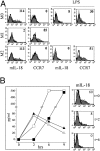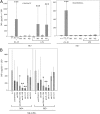The interaction of human natural killer cells with either unpolarized or polarized macrophages results in different functional outcomes
- PMID: 21118979
- PMCID: PMC3003022
- DOI: 10.1073/pnas.1007654108
The interaction of human natural killer cells with either unpolarized or polarized macrophages results in different functional outcomes
Abstract
The cross-talk among cells of the innate immunity can greatly affect both innate and adaptive responses. Here we analyzed the molecular interactions between human natural killer (NK) cells and autologous macrophages. Activated NK cells killed M0 and M2, whereas M1 macrophages were more resistant to lysis because of their higher expression of HLA class I molecules. Following exposure to LPS or bacillus Calmette-Guérin, M0 and M2, but not polarized (endotoxin tolerant) M1 macrophages, induced strong activation of resting NK cells. The expression of CD69 and CD25 activation markers and the acquisition of cytotoxicity against tumor cells and immature dendritic cells required soluble factors being mostly contact independent. On the contrary, IFN-γ production was contact dependent and required the interaction of DNAM-1 and 2B4 (on NK) with their ligands on macrophages as well as IL-18. IL-18 was involved also in the acquisition of CCR7 by NK cells. Interestingly, M0 and M2 cells expressed a membrane-bound form of IL-18, which was released in small amounts after LPS treatment. Our data indicate that, upon interaction with M0 macrophages exposed to microbial products, NK cells may amplify classical type 1 immune responses. In addition, M1-polarizing stimuli can rescue M2 macrophages from their immunomodulatory state and shape their functional behavior toward NK stimulatory capability.
Conflict of interest statement
Conflict of interest statement: A. Moretta is founder and shareholder of Innate Pharma (Marseille, France). The remaining authors have no conflicting financial interests.
Figures





References
-
- Moretta A, Locatelli F, Moretta L. Human NK cells: From HLA class I-specific killer Ig-like receptors to the therapy of acute leukemias. Immunol Rev. 2008;224:58–69. - PubMed
-
- Ma CS, Nichols KE, Tangye SG. Regulation of cellular and humoral immune responses by the SLAM and SAP families of molecules. Annu Rev Immunol. 2007;25:337–379. - PubMed
-
- Bottino C, Castriconi R, Moretta L, Moretta A. Cellular ligands of activating NK receptors. Trends Immunol. 2005;26:221–226. - PubMed
Publication types
MeSH terms
Substances
LinkOut - more resources
Full Text Sources
Other Literature Sources
Research Materials
Miscellaneous

